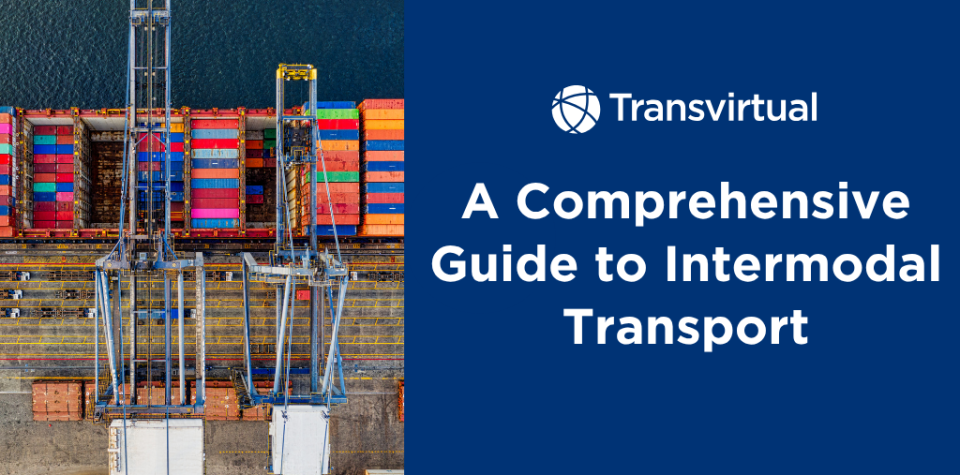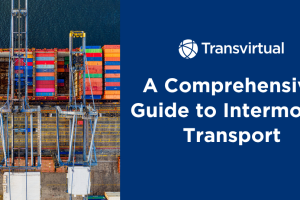Table of Contents
Intermodal transportation is transforming how freight moves across Canada. Various modes—rail, truck, and ocean—combine to create an integrated journey that saves time and money. Canadian railways alone transported 32.7 million tonnes of cargo by April 2025. The same source reveals that intermodal shipments from Canada reached 3.3 million tonnes, a 2.3% year over year increase.
Intermodal’s strength lies in combining each mode’s advantage: rail’s long-haul efficiency, trucks’ flexible local deliveries, and ocean shipping’s global reach.
This article will walk you through the basics: what intermodal transport is, why it matters, the benefits it brings, and how you can manage it successfully.
What Is Intermodal Transport?
Intermodal transport means moving freight with two or more transportation modes, such as rail, truck, or ship, without unloading the cargo inside the container. The cargo remains in the same container, transferred between carriers. For instance, a container may travel cross-country by rail, then be picked up by a truck for local warehouse delivery.
This is different from multimodal transport, where one carrier takes responsibility for the entire journey under a single contract, even if multiple modes are used. Intermodal, by contrast, often involves different contracts and providers working together.
Think of intermodal as a “team effort” across transport modes. The container is the constant, making the process more efficient, secure, and cost-effective while keeping goods moving smoothly across long distances.
What Is the Main Purpose of Intermodal Transportation?
The main purpose of intermodal transportation is to move freight more efficiently by combining the strengths of different modes. Rail, for example, is highly fuel-efficient for long hauls, while trucks provide flexibility for local pickup and delivery. Together, they create a cost-effective and reliable system that businesses can depend on.
Companies choose intermodal not just to save on costs but also to reduce risk and improve network flexibility. With more options for routing and capacity, shipments are less vulnerable to driver shortages, highway congestion, or rising fuel costs. For shippers, this means freight moves faster, greener, and with greater reliability than relying on a single mode alone.
Benefits of Intermodal Shipping: How It Delivers Value
Cost Savings
The biggest cost wins in intermodal shipments often happen during the long-haul legs. In Canada, rail is three to four times more fuel efficient than trucking, especially over longer distances. For example, Canadian railways moved 711 revenue ton-miles per gallon in 2022, a record level of fuel efficiency, as rail operators improve both locomotives and operational practices.
Shifting a large portion of the journey to rail makes a big difference: fuel savings and bulk-movement economies often more than offset the extra costs for drayage or handling that occur at the start and end of the route. Especially for cross-province or coast-to-coast hauls, using rail for the middle segment can lower total freight costs significantly when compared to relying only on trucks.
Sustainability
Rail intermodal delivers a strong climate advantage in Canada. In 2021, the rail sector emitted just 7.0 megatonnes of carbon dioxide equivalent, which represented approximately 4.7% of domestic transportation-related greenhouse gas emissions. Meanwhile, the road transportation sector (including freight trucks) accounted for 118 megatonnes of carbon dioxide equivalent or 79% of the country’s transportation emissions.
In practical terms, that means shifting freight from full truckload to intermodal rail routes helps reduce carbon impact significantly, since trucks dominate the emissions profile in Canada’s freight mix.
By converting a portion of freight transport from heavy trucking to rail-backed intermodal, companies can make real progress toward emission reduction goals, without giving up freight capacity or reliability.
Reliability
Trucks are vulnerable to road congestion, traffic delays, and driver shortages. Intermodal adds a rail leg, which is less subject to highway traffic spikes.
Rail capacity tends to be more stable and predictable over long distances.
Because intermodal distributes risk across networks and carriers, disruptions in one leg can sometimes be absorbed by alternatives.
Flexibility
Intermodal gives access to multiple carrier networks and routing options. If one route or carrier is down, shippers can pivot or shift to a different rail or drayage provider.
It also enables combining different modes (truck + rail + ocean) to tailor the path to cost, speed, or geographic constraints.
Scalability
As a company grows, its shipping volumes tend to rise. Intermodal scales well because rail has high capacity for bulk movement.
Instead of relying purely on trucks (which might struggle with volume), intermodal lets you handle surges without proportionally increasing cost or risk.
Because infrastructure (rails, terminals) is already in place, expanding volume often has a lower marginal cost compared to building entirely new truck fleets.
Key Components: Different Modes of Intermodal Transportation
The strength of intermodal lies in its ability to combine different transportation modes into one seamless freight journey. Each mode plays a unique role, and containers act as the common thread that keeps cargo secure and transferable without the need for unloading and reloading goods.
Rail
Rail is the backbone of long-haul freight in Canada. Trains can efficiently move large volumes across thousands of miles, making them ideal for the middle leg of an intermodal journey. For shipments moving coast-to-coast, rail offers both cost savings and energy efficiency, handling bulk flows that trucks alone would struggle to manage economically.
Trucks
Trucks fill in the gaps by providing drayage, the short hauls that connect rail terminals, ports, and final destinations. They’re also essential for last-mile delivery, ensuring freight gets from an intermodal hub to a warehouse, distribution center, or store. Trucks bring the flexibility and geographic reach that rail or ships can’t, giving intermodal its vital “first mile” and “last mile.”
Ocean shipping
Ocean shipping is what makes intermodal truly global. Containers arriving at Canadian ports from Asia, Europe, or South America can be seamlessly transferred onto trains or trucks for inland distribution. Ocean carriers provide the international scale and cost-effectiveness needed to move massive volumes, while intermodal networks make sure those goods don’t get stuck at the port.
Air freight
Air freight plays a smaller, optional role in intermodal transport but is crucial for high-value or time-sensitive cargo. While it’s more expensive than ocean or rail, air can bridge long distances quickly and link into truck networks for rapid distribution once the cargo lands. For some industries, like electronics or pharmaceuticals, combining air with other modes keeps supply chains moving without compromise on speed.
What ties all these pieces together is the standardized shipping container. Containers allow cargo to be loaded once, then transferred between ship, rail, and truck without being touched again until it reaches its final destination. This reduces handling costs, minimizes damage or loss, and speeds up the process. Whether it’s crossing the ocean, rolling on a train, or riding on a truck chassis, the same container ensures that freight flows smoothly through every stage of the intermodal chain.
5 Toughest Challenges in Intermodal Transportation
Intermodal shipping has clear benefits, but it isn’t without hurdles. Businesses that use intermodal need to plan carefully for the following challenges and know how to navigate them.
Delays and congestion
Ports, terminals, and rail yards are often bottlenecks where freight can get stuck. Congestion leads to missed connections and longer transit times. To minimize risk, shippers can build in buffer time and work with providers who have access to priority lanes or alternate terminals. Using real-time data feeds from carriers also helps spot disruptions early.
Coordination complexity
Each intermodal move involves drayage providers, railroads, ocean carriers, and sometimes air cargo. Miscommunication between them can lead to missed handoffs or costly delays. A strong transportation management system (TMS) can bring visibility to all legs of the journey, while partnering with an experienced third-party logistics (3PL) provider ensures that someone is orchestrating the entire chain.
Limited Infrastructure
Not all regions have robust intermodal networks. Rail capacity can be constrained, and some ports lack the infrastructure to handle growing container volumes. Businesses can overcome this by diversifying entry points, like using secondary ports, and by planning seasonal surges well in advance. Long-term, building relationships with carriers that invest in infrastructure upgrades can also pay off.
Visibility Gaps
Tracking freight across trucks, trains, and ships can be a challenge, as not every carrier provides the same level of digital transparency. This can make it difficult to give customers accurate ETAs. The solution is to integrate tracking tools that pull data from multiple carriers into one dashboard. Many TMS platforms now offer this capability, giving shippers end-to-end visibility instead of piecemeal updates.
Equipment Shortages
Intermodal depends on having the right containers, chassis, and rail cars at the right place and time. When shortages occur, as seen during recent supply chain disruptions, shipments can be delayed or rerouted. Companies can reduce exposure by working with providers who maintain their own equipment pools or by securing capacity contracts during high-demand seasons.
How to Manage Intermodal Freight
Managing intermodal freight successfully is all about coordination, visibility, and planning. Because shipments move through several modes, truck, rail, and sometimes ocean, keeping everything aligned requires the right tools and partners.
A transportation management system (TMS) is the foundation for smooth intermodal operations. It centralizes planning, booking, and tracking across carriers, giving logistics teams a single source of truth. With visibility platforms connected to carrier data, you can see where your containers are in real time, whether they’re at a rail yard, in transit on the highway, or waiting at a port. This transparency helps avoid surprises and enables proactive decision-making when disruptions occur.
Coordinating multiple partners is another key piece. Drayage providers handle first and last-mile legs, rail carriers manage long hauls, and sometimes ocean lines or brokers add international connections. Each handoff needs clear communication and precise scheduling to stay on track. Regular updates and automated alerts through a TMS help ensure that every link in the chain knows what’s next, reducing dwell time and missed transfers.
Tracking and scheduling go hand in hand. Because different modes operate on varying timetables, having up-to-date visibility helps you plan arrivals and departures accurately. Integrating data from multiple carriers into one platform can cut manual follow-ups and streamline operations, freeing up teams to focus on exceptions rather than chasing updates.
For businesses, several practical steps make intermodal management easier:
Work with an experienced 3PL or freight broker. These partners already have established relationships with drayage, rail, and ocean providers, making it easier to secure capacity and solve problems quickly.
Use TMS platforms for planning and optimisation. Tools that offer load consolidation, rate comparison, and automated scheduling can help you lower costs and improve on-time performance.
Plan for buffer times and contingencies. Even the best schedules face hiccups from weather, port congestion, or equipment shortages. Allowing flexibility in your timeline helps protect delivery commitments and maintain customer trust.
Why Intermodal Matters
Intermodal transportation brings together the best of every mode: the efficiency of rail, the flexibility of trucking, and the global reach of ocean shipping. It helps businesses lower costs, improve reliability, and cut their carbon footprint, all while keeping supply chains agile and scalable. For companies looking to move freight smarter, intermodal isn’t just an option; it’s a strategy. Partnering with an experienced logistics provider and using a powerful TMS like Transvirtual can help you coordinate every leg seamlessly, gain real-time visibility, and unlock the full value of intermodal transportation.


